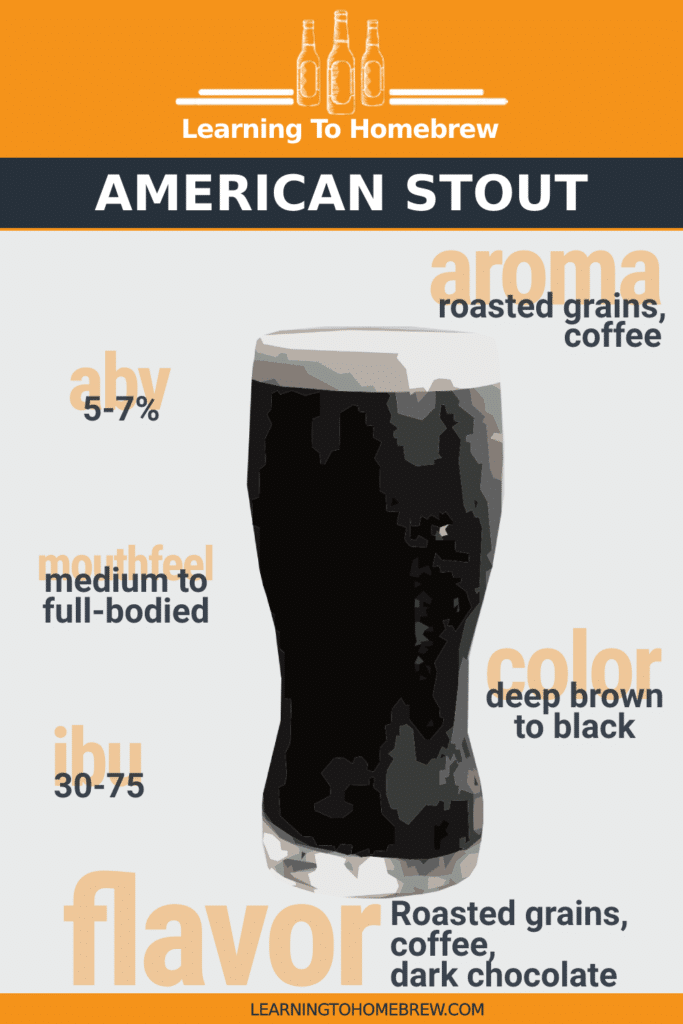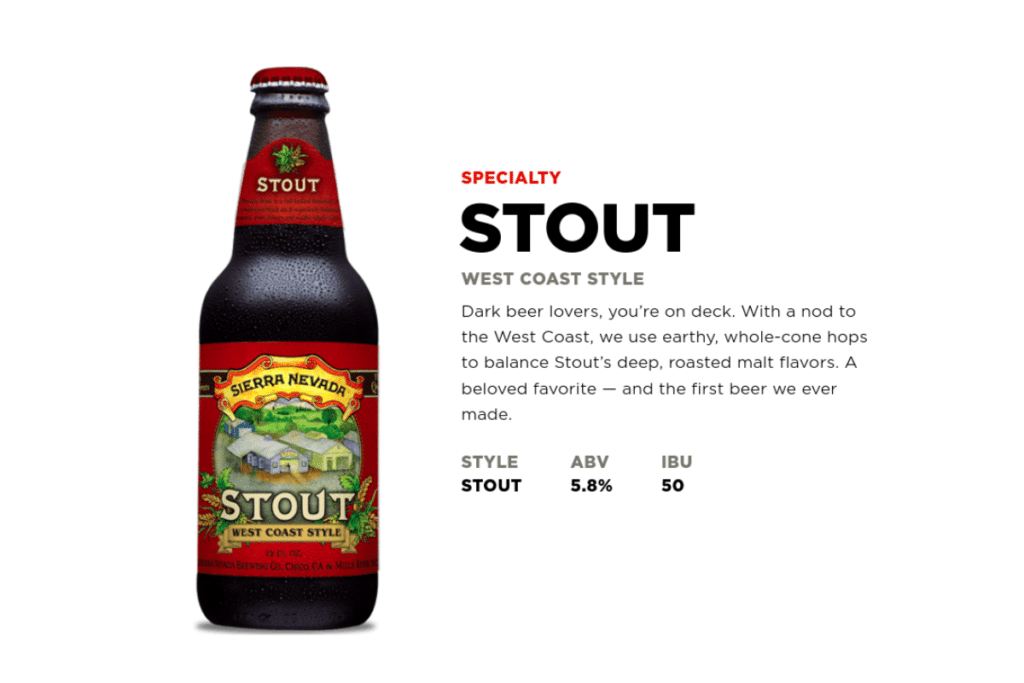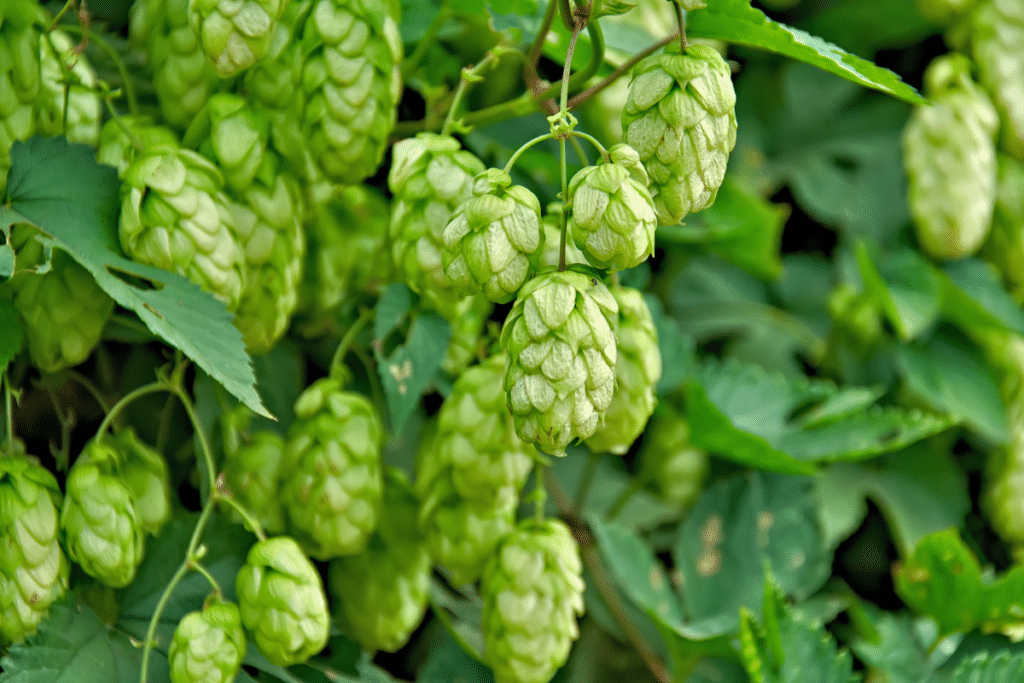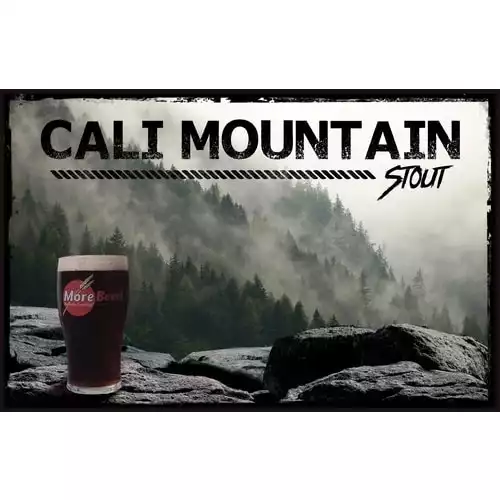When you enjoy both malty stouts and hoppy IPAs you may be wondering if there’s a beer that satisfies both cravings. The answer to this is the American Stout. If you want to try your hand at brewing this hoppy stout you’ll need to know all about it.
Brew a bold American Stout with hard water with slightly more sulfates than chlorides for the hoppy bitterness of the style. Fill your grain bill with US 2-row and your choice of roasted barley, chocolate malt, black malt, crystal malt, or a combination. Choose American hops and yeast with high attenuation, high flocculation, and low esters.
Keep reading to learn all about the classic American stout, including common ingredients and popular brewing methods. I’ve even included a few recipes to get you started!
Topics We Cover
What is an American Stout?
An American Stout is bolder in flavor and body than other stouts it is still lighter than an Imperial Stout. The high end of the ABV range for an American Stout does not reach the low ABV end of an Imperial Stout. It is closer in ABV to a Foreign Extra Stout, although that style lacks the hoppiness associated with the American version.
The American Stout’s bold flavors include roasted malt, coffee, and hop bitterness. This dark beer is distinctive with its dark malts, strong hop characteristics, and a touch of malt sweetness. It has a full body with generous carbonation.
Like many American beer styles, the American Stout has a stronger hop presence. Many Stout styles utilize hops for their bittering capabilities but few incorporate the hop flavors and aromas to the degree that American Stouts do.

Defining characteristics of American Stouts include:
- Color – 30 – 40 SRM
- Common flavor – Roasted grains, coffee, dark chocolate, bitterness
- Aroma – Roasted grains, coffee, medium to light hop aromas
- Mouthfeel – Medium to full-bodied, medium-high to high carbonation, creamy
- IBUs (Bitterness) – 30-75
- ABV – 5-7%
Another name for an American Stout is a West Coast Stout.
History of the American Stout
Like all stouts, the American Stout can be traced back to Britain and its porters. The American Stout was first brewed during the rise of craft brewing in the 1970s. One of the first microbreweries, New Albion Brewing Co., brewed a stout with heavy American hop usage. The beer, simply named New Albion American Stout, is credited as being the first instance of the American Stout style.
Two years before New Albion Brewing Co. went under in 1982, Sierra Nevada Brewing Co. brewed its first beer, a West Coast Stout.
It was this high use of American hops that set the American Stout apart from other Stouts. The three big “C” hops are commonly found in American Stouts. Today, the Sierra Nevada Stout uses Bravo, Cascade, and US Goldings hops.
Popular commercial American Stouts
For the beer enthusiasts and the beer curious here’s a quick list of American Stouts you should try.

- Sierra Nevada Stout – One of the oldest American Stouts on the market today. Sierra Nevada Stout is a delicious blend of earthy hops and dark roasted malt flavors.
- Deschutes Obsidian Stout – A simple appearing stout, this beer from Deschutes Brewery provides a complex flavor profile.
- Bell’s Kalamazoo Stout – This stout brings the strong flavors of dark chocolate and roasted coffee to hop flavors in a great way.
- Rogue Chocolate Stout – Rogue’s Chocolate Stout is nitro charged to provide a smooth creamy beer with notes of roast malt flavors, chocolate, and notes of bitterness.
Popular American Stout recipe kits (all-grain or extract)
If you are interested in the Sierra Nevada Stout above, here is the clone recipe kit for it!
An excellent clone kit of Sierra Nevada's Stout!
The end result is a bold but smooth malt flavor, backed by about 50 IBUs and an ABV around 5.7%.
How to brew an American Stout
Once you’ve explored some great examples of an American Stout, you may start thinking about what it would take to brew your own. In order to brew the best beer you need to know the style forward and backward. To that end, I will break down everything you need to know.
Brewing an American Stout requires hard water with slightly more sulfates than chlorides – this will enhance the hoppiness. You’ll also need base grain such as US 2-row grain and bittering hops as well as roasted barley, chocolate malts, American black malt, and sometimes crystal/caramel malts. Finally, choose a yeast with medium to high attenuation, high flocculation, and low ester production.
Let’s start by going over some great choices for the recipe and ingredients. Then, we can look at the process including brew day, fermentation, and bottling.
Recipe and ingredients
While you can’t have beer without fermentation, you can’t get anywhere without quality ingredients. There are of course no wrong ingredients, but some will go together much better than others.
As always, start with your water. Since beer is nearly 90% water, good water makes good beer. Then consider your grain bill, hops, and finally yeast. Each one can have a significant impact on your final product.
Water profile
It may be easy to take water for granted, but it makes a huge difference in the final product and often needs to be customized to be appropriate for the beer you’re brewing. Since about 85% of the U.S. has hard water, you’re probably well on your way to having the right water for this brew
The best water profile for an American Stout is hard water with a slight lean toward sulfates over chlorides. Account for the pH drop from dark malts by using a mash pH calculator.
Sulfates in the water profile add to the hop characteristics and overall bitterness. Chlorides on the other hand enhance malt flavors. You would typically want a chloride lean in a stout. In this case, favoring sulfates slightly will accentuate the fact that American Stouts include hop flavors.
The hard water will help you offset the pH drop that the dark malts you’ll use will bring. When you know your grain bill you can use a calculator to determine how much alkalinity you’ll need to reach an appropriate mash pH.
If you use a water profile calculator or follow historical profiles, use a water profile similar to Dublin’s. This water profile serves as a decent starting point for many stouts.
Base grains
Your base grains will set up the canvas for your specialty grains to add color and depth. Since this is the case, any pale malts will do the job here.
A good base grain for an American Stout is any US 2-row grain. Alternatively, you can use a Pale Ale malt.
US Pale 2-row will work great though British malts are also a good choice.
Specialty grains or other additions
Specialty grains add the flavor complexity and dark color a stout should have.
An American Stout calls for roasted barley, chocolate malts, American black malt, and sometimes crystal/caramel malts. All of these are great options.
Favor roasted barley for bitterness and roasted malt flavors. Chocolate malts are great for dark chocolate flavors with a hint of burnt flavors.
Choose black malts for roasted malt flavors and slightly less bitterness than roasted barley. Caramel malts are great for adding a little sweetness and body.
As for other additions, flaked oats can also be used to add body and some head retention.
Hops
Hops play a role in the flavor and aroma of all beer styles, although how heavily they are featured in the final flavor varies significantly.
An American Stout uses hops for both bittering and flavor or aroma. American hop varieties are the most common but are not the only option. Since there is some variation in the level of hop characteristics choose your favorite complementary hops.

The hops in an American Stout aren’t the sole focus. They share the spotlight with the malt flavors. With this in mind, choose hops that will provide complexity to your beer. As taste is subjective there are few wrong answers.
Bittering
Bittering hops added early in the boil will go through a process called isomerization. This is what gives a beer its bitterness.
An American Stout calls for anywhere from 35 to 75 IBUs. Look for high Alpha Acid hop varieties.
Here are some good choices for bittering hops.
| Name | Purpose | Alpha Acid % |
| Magnum | Bittering | 12-14% |
| Centennial | Bittering + Aroma | 7-12% |
| Chinook | Bittering + Aroma | 12-14% |
| Cascade | Bittering + Aroma | 4.5-7% |
Aroma and flavor
Aroma and flavor hops added towards the end of the boil don’t add much bitterness. Instead, they add oils that provide flavor and aroma. American Stouts will make use of one or two late additions.
Unlike most stouts, American Stouts have a good deal of hoppiness. The best hops will be American without too much citrus.
Here are a few good choices to get you started.
| Name | Flavor/Aroma | Alpha Acid % |
| Cascade | Citrus, floral | 4.5-7% |
| Centennial | Floral, citrus, woody | 7-12% |
| Fuggles | Vegetal, woody, floral | 3.5-6% |
| East Kent Goldings | Woody, citrus, spicy, vegetal | 4.5-6.5% |
Yeast
An American Stout calls for a yeast strain that has medium to high attenuation, high flocculation, and low ester production.
The best stout yeast strains will typically let the malt flavors shine without adding too much. Most leave the beer fairly dry at the end.
Dry
Below are some good dry yeast options for an American Stout.
| Name | Attenuation | Flocculation | Temp Range |
| Safale US-05 | 78-82% | Medium | 64.4-78.8°F |
| Safale S-04 | 74-82% | High | 64.4-78.8°F |
| Nottingham | 77% | High | 50-72°F |
Liquid
Below are some good liquid yeast options for an American Stout.
| Name | Attenuation | Flocculation | Temp Range |
| Wyeast 1056 | 73-77% | Low – Medium | 60-72°F |
| WLP004 | 69-74% | Medium – High | 65-68°F |
| WLP001 | 73-85% | Medium | 64-73°F |
Brewing process
After acquiring all of your ingredients you can move on to brew day. What you do on brew day can have just as much impact on your results as your choices of ingredients. On brew day, one of the most important aspects is sanitization. Be thorough when sanitizing.
All grain, partial, and extract brewing each have important considerations for you to make. When doing all-grain or partial brewing you need to consider mashing and sparging. From there the other considerations are similar. The boil step and on is the same for all three.
Let’s break down each step with the American Stout in mind.
Mashing
For an American Stout, your mash temperature should be between 152°F and 154°F. This range will ensure a decent body with a dryer finish.
You shouldn’t need to mash longer than an hour. In fact, 45 to 50 minutes should do just fine. Since this is a darker beer you may need to pay additional attention to your mash pH. However, if your water profile is just right you’ll be fine.
If you have oats in your grain bill you can mash on the lower end as the oats will provide enough body.
Boil
The boil for an American Stout should be an hour long. You should have an early hop addition and a late addition. Some recipes may break up the additions over the hour or have several different varieties at different times.
High Alpha Acid hop varieties are great for early additions if you are going for a high IBU American Stout. Typical addition times are 60 and 45 minutes left for early additions. Late additions are typically at either 15 or 5 minutes left.
Whirlpool or flameout
Boil aside, there are other times to add hops. They aren’t strictly necessary but can be great for adding flavor and aroma.
Adding hops during flameout can be a great way to get the flavors and almost no bitterness. This is done directly after the boil and before you pitch yeast. As you transfer to your fermentor create a whirlpool as you drain the boiling vessel.
This is only possible when you have a vessel that can drain from the bottom. Whirlpooling can also be a great way to collect the trub in the middle and reduce the amount that gets in your fermentor.
Fermentation
As always, fermentation is crucial but mostly hands-off.
Keeping the fermentation temperature consistent aside from deliberate step-ups is crucial for quality beer. Be sure to avoid direct sunlight and keep the temps low for an American Stout.
Keeping the fermentation on the lower end will help keep your brew clean from any fermentation byproducts.
Temperatures
While the temperatures are yeast dependent, there is a rough range you should keep your American Stout near. Try to keep your fermentor around 63-68°F throughout the process.
If you miss your temp goals by a few degrees or can’t keep it consistent it won’t be the end of the world. This level of micromanaging is great for elevating your final product but isn’t essential.
Bottling or kegging
The debate between bottling and kegging will go on for as long as brewers have a choice. It is truly up to personal preference and setup.
There is little preference between bottling and kegging for American Stouts. Kegging will allow you to bulk condition while bottles can make it easier to save portions for aging.
Choose the method that is easiest for you.
American Stout recipes
If you aren’t one to create your own recipes here are a few that you can follow for great results.
These recipes are from various brewers as credited below.
- Super Simple Stout (All Grain)
- Sierra Nevada Stout Clone (All Grain)
- German Chocolate Cake Stout (Extract)
Super Simple Stout (All Grain)
This recipe comes from user llvtt on Brewer’s Friend.
Ingredients
- US Pale Ale – 10 lbs
- US Caramel 75° L – 1 lb
- US Chocolate – 0.75 lb
- UK Roasted Barley – 0.5 lb
- Simcoe hops – 0.75 oz
- WLP013
Method
- Heat 4.3 gallons to 152°F.
- Add grain bill and mash for 1 hour.
- Mashout.
- Collect 7 gallons of wort.
- Boil for 90 minutes. Add the Simcoe at the beginning.
- Flameout and transfer to the fermentor.
- Cool and pitch yeast.
- Maintain 65° F during fermentation.
- Rack to keg or bottles when fermentation finishes. Enjoy!
Sierra Nevada Stout Clone (All Grain)
This recipe comes from user Brewer #118487 on Brewer’s Friend.
Ingredients
- UK Pale 2-row – 9.63 lbs
- German Munich Light – 3.19 lbs
- US Caramel 60° L – 0.94 lb
- UK Black Patent – 1.19 lbs
- Magnum hops – 1 oz
- Cascade hops – 1.10 oz
- Willamette hops – 2.40 oz
- Safale US-05
Method
- Heat 4.7 gallons to 154°F.
- Add grain bill and mash for 1 hour.
- Mashout.
- Collect 7.5 gallons of wort.
- Boil for 60 minutes. Add the Magnum at the beginning.
- At 10 minutes left add the Cascade.
- Flameout and add the Willamette. Then transfer to the fermenter.
- Cool and pitch yeast.
- Maintain 64°F during fermentation.
- After fermentation, rack to keg or bottles. Enjoy!
German Chocolate Cake Stout (Extract)
This recipe comes from user Stevek23 on Brewer’s Friend.
Ingredients
- LME Dark – 6 lbs
- Rolled Oats – 8 oz
- UK Coffee Malt – 4 oz
- US Roasted Barley – 64 oz
- Fuggles hops – 1 oz
- Safale S-04
- Pecan extract – 2 oz
- Coconut – 16 oz
- Cocoa nibs – 10 oz
- Wyeast beer nutrient – 0.5 tsp
- Whirlfloc
Method
- Heat 6.5 gallons of water for your boil.
- Add the steeping grains when the water is around 140°F.
- Steep for roughly 20 minutes.
- Remove the grains when the water is around 170°F.
- When a boil is reached, add the malt extract.
- Boil for 60 minutes. Add the hops right away.
- At 15 minutes left, add the beer nutrients and the whirlfloc.
- Flameout and transfer to the fermentor.
- Cool and pitch yeast.
- Maintain 62°F during fermentation.
- After fermentation, rack to secondary and add the cocoa nibs and coconut.
- After a week or so on secondary, rack to keg and force carbonate or bottle condition. Add the pecan extract to the keg or bottles.
Did you know that we have a full library of homebrew beer recipes for every style?


